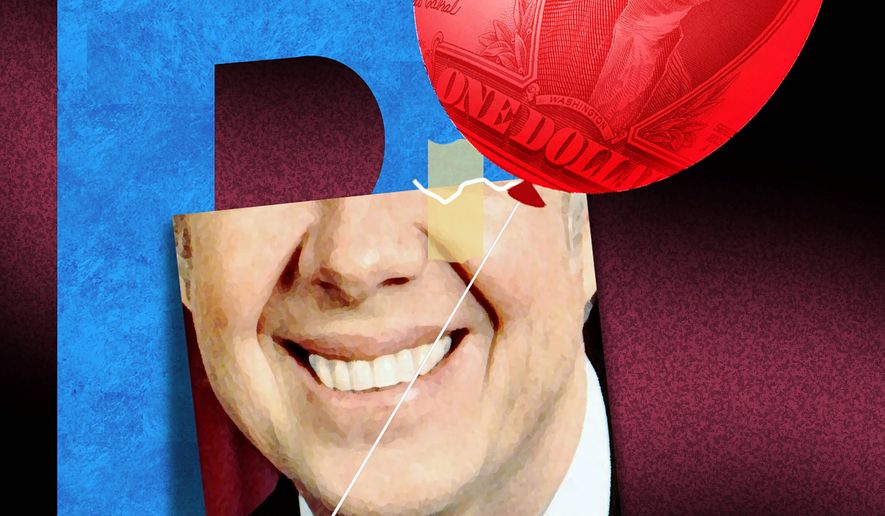OPINION:
The Consumer Price Index report for May indicated a 5% increase in consumer prices over May 2020. The report suggests that the United States is on track to experience a 9.0% increase in consumer prices in 2021.
That would be the largest annual increase in inflation since 1980, when it was 12.5%.
To say that is concerning, especially to those of us who lived through the terrible, dispiriting runaway inflation of the 1970s, is to wildly underestimate how bad the news is.
In the 1970s, inflation routinely reached double digits, and it only came under control because of the intense, damaging recessions of 1980 and 1982, which consisted of three years of high prices and high unemployment. Those recessions first cost President Carter his job and later, the Republicans control over the Senate, effectively limiting the accomplishments of the Reagan administration.
Inflation is a thief that steals from everyone; it is corrosive to economic growth and, more importantly, to the confidence of citizenry in the economy and the government.
Inflation crushes those on fixed incomes, the poor and the elderly, because they can’t readily make or access more money to meet the rising costs. Those working also suffer, as prices increase faster than wages. People are priced out of things, like education and housing, that help build long-term wealth. Those who own stocks are hurt as well; the market mantra is “when prices are high, stocks will die”.
Local institutions like schools and hospitals on mostly fixed budgets are damaged.
In short, a 9.0% annual rate of inflation is the same as a 9% pay cut if you’re working, or a 9% reduction in the value of your retirement, Social Security or of your stock portfolio.
Inflation affects small business. An owner of a salon in my hometown recently told her customers that she was closing up shop, mostly because everything she purchased — supplies, IT support, payroll management, etc. — had become dramatically more expensive and she either could not or would not pass the costs (which would have doubled the price of haircuts) along to her customers. She closes at the end of July.
It affects farmers and those who eat. A friend from the middle of the country wrote a few weeks back that his local farm supply store has been experiencing increased prices from suppliers. Those increased costs get passed right along to consumers.
Inflation affects those who drive, or who use anything transported by anything other than mule train. In the last five months, the price of gasoline has increased from less than $2 per gallon to more than $3 per gallon.
Why has the scourge of inflation revisited the United States? Mostly because President Biden, in his desperate and sad quest for a legacy, any legacy, injected almost $2 trillion into an economy that didn’t need it. Now he wants to inject another $6 trillion into an already overheated economy through his “infrastructure” and “families” plan.
It’s crazy.
What’s worse is, Mr. Biden knows it’s crazy. He has talked more than once to Larry Summers, former secretary of the treasury to President Clinton and director of the National Economic Council under President Obama whose skepticism of the American Rescue Plan is well-known. Mr. Summers has been clear: “Inflationary pressures are mounting from the boost in demand created by the $2 trillion-plus in savings that Americans have accumulated during the pandemic; from large-scale Federal Reserve debt purchases … from roughly $3 trillion in fiscal stimulus passed by Congress …”
Jason Furman, chairman of President Barack Obama’s Council of Economic Advisers, has also said that the American Rescue Plan is definitely “too big for the moment,” and: “I don’t know of any economist that was recommending something the size of what was done.”
Even a through and through company man like Steve Rattner, who led Mr. Obama’s bailout of the automobile industry and is an MSNBC contributor and opinion writer for The New York Times, was rude enough to tweet that: “ … inflation is accelerating rapidly and prices are above trend. We need to trim stimulus now!”
Mr. Biden doesn’t care. Even after talking to Mr. Summers personally, he still continues to pursue this reckless and damaging path of spraying cash into an economy that doesn’t need it and can’t use it.
What are we getting for the trillions more Mr. Biden proposes to put on the credit card? Nothing, as best anyone can tell. The budget submitted a few days ago by Team Biden projects slow economic growth — in the neighborhood of 2% a year — for as far as the eye can see.
It turns out that the Biden years will not be a rerun of the Clinton administration or the Obama administration. They will be a rerun — complete with runaway inflation and slow growth — of the Carter administration.
• Michael McKenna, a columnist for The Washington Times, is the president of MWR Strategies. He was most recently a deputy assistant to President Trump and deputy director of the Office of Legislative Affairs at the White House.




Please read our comment policy before commenting.